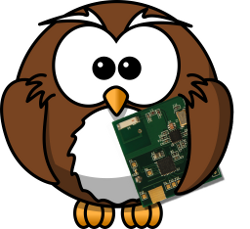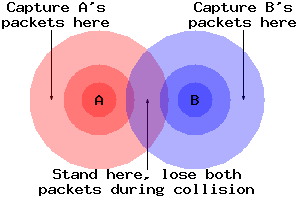Ben Firner's Research
Owl Platform (Circa 2018)

With all of the hype about the "Internet of Things" it would be nice if you could put your things online. This is a long-term project with another student Rutgers (Robert Moore) with the goal of creating a software stack that makes it easy to make physical spaces, like your house, smarter. This problem can be divided into several areas: sensing, data collection, data processing, and actuation on that data. Owl platform focuses on the last three areas, and is hardware agnostic, allowing you to choose your own sensing solution. Interested? Check it out!
Transmit Only (2014 PhD Thesis)
Changing batteries in your devices is annoying; changing batteries in 100 sensors throughout your home is impossible. Traditional wireless protocols care more about data connectivity than power consumption, but if we want a world with tiny sensors then our wireless protocols need to use tiny batteries and still last for years. My solution to this problem is a transmit-only protocols that exploits the capture effect to mitigate packet collisions. This is a zero-overhead protocol for the transmitters, so our sensors last for years on a single coin cell battery. Read more about it in my thesis.

Published Work
Improving RF-Based Device-Free Passive Localization in Cluttered Indoor Environments Through Probabilistic Classification Methods
Xu, C.; Firner, B.; Zhang, Y.; Howard, R.; Li, J.; Lin, X.;
IPSN'12, pp209-220.
My labmate, Chenren Xu, does location estimation using the radio links from the sensing system we deployed in the lab. This is the same system that is tracking when coffee is brewed, so reusing the radio links for other purposes is pretty cool!
Multiple Receiver Strategies for Minimizing Packet Loss in Dense Sensor Networks
Firner, B.; Xu, C.; Howard, R; Zhang, Y.;
MobiHoc'10, pp211-220, September 20-24, 2010.
URLs: Paper and
Slides
This is preliminary work on the effectiveness of the capture effect. Future papers will have more complete comparisons with other protocols.
The data for the 100 transmitter trial is here. This
84 megabyte file will expand to over a gigabyte so be careful. There is a README in the
archive. The collision phases data is available here.
If you use this data in a publication please cite the paper.
Detecting Intra-Room Mobility with Signal Strength Descriptors
Konstantinos, K.; Firner, B.; Howard, R.; Zhang, Y.; Martin, R.;
MobiHoc, 2010.
URLs: Paper and
Slides
I did half of the writing and all of the classification for this paper, using Weka and a lot of shell scripts.
Some of the mobility traces are also available online here. Contact me for a full trace (it's not all online due to its size).
Towards Continuous Asset Tracking: Low-Power Communication and Fail-Safe Presence Assurance
Firner, B.; Jadhav, P.; Zhang, Y.; Howard, R.; Trappe, W.; Fenson, E.
Sensor, Mesh and Ad Hoc Communications and Networks, 2009. SECON '09. 6th Annual IEEE Communications Society Conference on , vol., no., pp.1-9, 22-26 June 2009
URL: IEEEXplore link and paper
Demo abstract: Towards Continuous Tracking: Low-power Communication and Fail-Safe Presence Assurance
Firner, B.; Jadhav, P.; Zhang, Y.; Howard, R.; Trappe, W.
Information Processing in Sensor Networks, 2009. IPSN 2009. International Conference on , vol., no., pp.417-418, 13-16 April 2009
URL: IEEEXplore link
PIP Tags: Hardware Design and Power Optimization
Firner, B.; Shweta, M.; Zhang, Y.; Howard, R.; Trappe, W.; Wolniansky, P.; Fenson, E
The Fifth Workshop on Embedded Networked Sensors, HotEmNetS 2008. 2 June 2008
URL: Paper